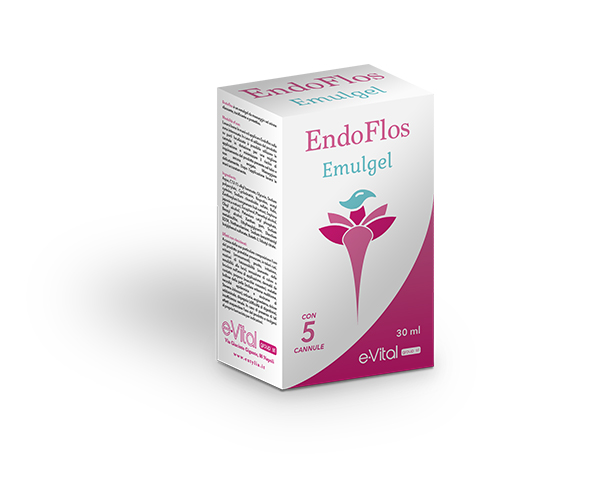EndoFlos Emulgel
- How to use
Apply one dose each evening for 7 days before the menstrual cycle, filling the applicator with gel entirely.
- Active ingredients
- Ibuprofen
- Zantalene
- N-acetylcysteine
- Rutin
- Chondroitin sulfate
Thanks to its active ingredients, it can also be recommended for a massage with relaxing, toning, and protective effects.
- Why EndoFlos Emulgel?
The emblematic symptom of endometriosis is pain. The initial dysmenorrhea caused by endometriosis quickly transforms into severe pelvic pain, which then becomes chronic. This pain can reach levels that become debilitating, compromising the quality of daily life and tends to worsen over time. Common comorbidities include fatigue, gastrointestinal symptoms, pain during defecation, especially during menstruation, dysuria, headache, nausea, and dyspareunia. The pain consumes vital energy, leaving the woman fatigued and depressed. The state of chronic inflammation associated with endometriosis involves:
– Hyperactivation of “mast cells,” which not only produce inflammation factors but also the nerve growth factor (NGF), leading to the proliferation of pain nerve fibers and a shift from nociceptive to neuropathic pain.
– Hyperactivation of the pain system, resulting in increased production of pain signals traveling to the brain, recruitment of normally silent pain fibers called “A delta” and “C,” cross-talk between pain fibers in nearby organs, explaining the progressive spread of pain throughout the pelvis and to organs such as the bladder, intestines, rectum, etc., and lowering the central pain threshold.
– Hyperactivation of the muscular system, with painful tensions in both the pelvis and generalized areas, causing antalgic postural alterations.
This involvement of multiple systems and associated comorbidities require a multimodal therapeutic approach, not limited to menstrual cycle suppression but capable of simultaneously reducing the various hyperactivations contributing to the development and maintenance of chronic pelvic pain.
Medical therapy for endometriosis aims primarily to reduce pain. The first-line drugs are NSAIDs (non-steroidal anti-inflammatory drugs), which, when administered orally continuously, can have numerous side effects.
The most appropriate choice for a comprehensive therapy that acts on different components of pain, achieving reductions in painful symptoms to restore quality of life, involves active principles that control inflammation, modulate non-menstrual pelvic pain, and reduce the use of oral analgesic drugs.
EndoFlos is an innovative preparation that allows for an immediate reduction of pain, even in the early applications, in cases of mild to moderate endometriosis.
- Bibliography
1. Zondervan KT, Becker CM, Missmer SA. Endometriosis. N Engl J Med 2020;382:1244-56. doi:10.1056/NEJMra1810764
2. Giudice LC. Clinical practice. Endometriosis. N Engl J Med. 2010 Jun 24;362(25):2389-98
3. Becker CM, Bokor A, Heikinheimo O, et al, ESHRE Endometriosis Guideline Group. ESHRE guideline: endometriosis. Hum
Reprod Open 2022;2022:hoac009. doi:10.1093/hropen/hoac009
4. Dunselman GA, Vermeulen N, Becker C, Calhaz-Jorge C, D’Hooghe T, De Bie B, Heikinheimo O, Horne AW, Kiesel L, Nap A, Prentice A, Saridogan E, Soriano D, Nelen W; European Society of Human Reproduction and Embryology. ESHRE guideline:
management of women with endometriosis. Hum Reprod. 2014 Mar;29(3):400-12
5. Saha R, Pettersson HJ, Svedberg P, et al: Heritability of endometriosis. Fertil Steril 104 (4):947–952, 2015. doi:
10.1016/j.fertnstert.2015.06.035 Epub 2015 Jul 22
6. Nnoaham KE, Hummelshoj L, Webster P, et al, World Endometriosis Research Foundation Global Study of Women’s Health
consortium. Impact of endometriosis on quality of life and work productivity: a multicenter study across ten countries. Fertil
Steril 2011;96:366373.e8. doi:10.1016/j.fertnstert.2011.05.090
7. https://www.sigo.it/wp-content/uploads/2017/09/Linee-Guida-Endometriosi-finale
8. Andrew W Horne, Stacey A Missmer Pathophysiology, diagnosis, and management of
endometriosis-DOI10.1136/bmj-2022-070750.BMJ 2022 Nov 14;379:e070750.doi: 10.1136/bmj-2022-070750
